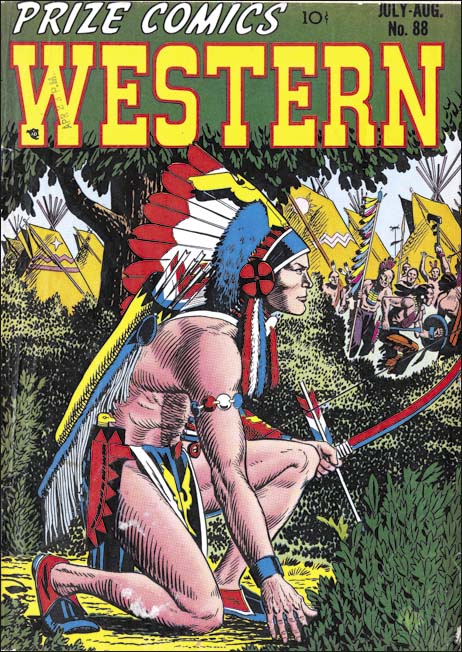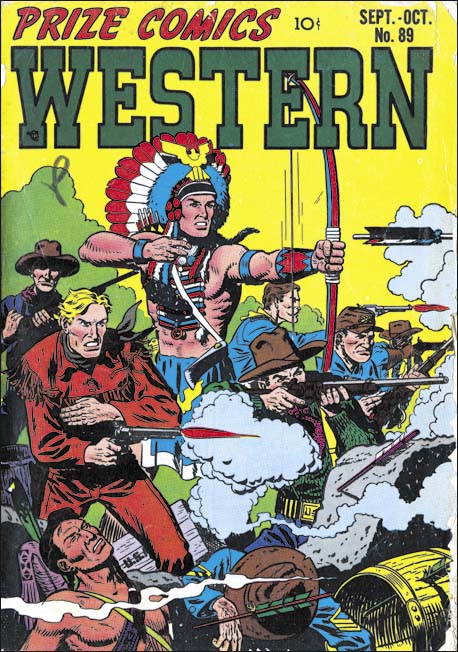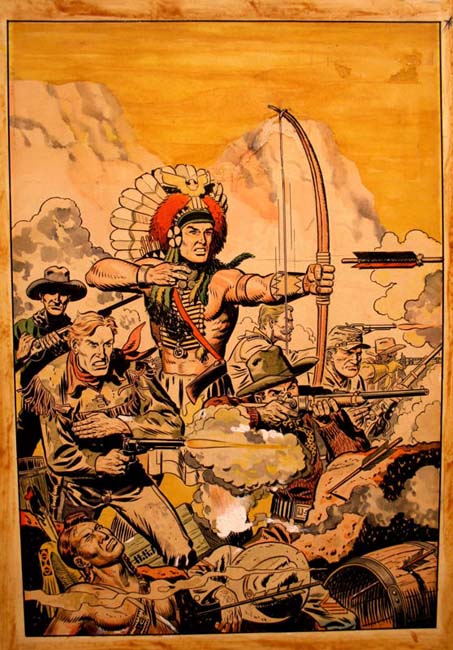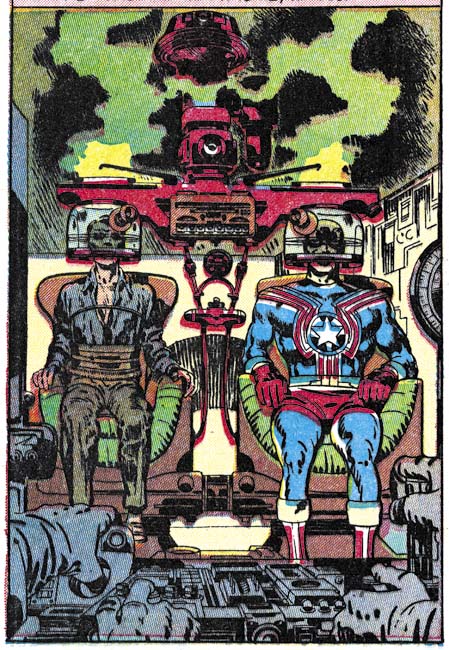It has been a couple of years since I discussed the topic of Kirby Kolors (Kirby Kolor, a Kirby Myth and Kirby Kolors, Revisited). Here I though I would write about some true Kirby Kolors, although they are rather special cases.

Prize Comics Western #88 (July 1951) pencils by John Severin

Prize Comics Western #88 (July 1951) pencils by John Severin, original art colored by Jack Kirby
Recently Kirby scholar and former assistant Steve Sherman sent me some scans of comic art still in the possession of the Kirby family. The one I show above was the original art for the cover of Prize Comics Western #88 (July 1951). This art was not done by Jack Kirby but instead was penciled by John Severin. Bill Elder inked much of the work that Severin did for Prize comics but I cannot say if that was the case here. But the thing that makes this work truly unusual is the coloring that has been applied. The color guides provided to the printers were originally done on silver prints of the line art, not on the original art itself. That this was true in for this cover can be seen on the many differences between the art and the published cover. For instance the original art shows American Eagle with a bright orange band in his head piece that was colored blue or cyan on the published cover. The teepees in the background of the art show a variety of colors while on the actual cover they are all light orange. The bush in the lower right corner has three colors in the art but a single green on the printed version.
The original art for the #88 cover has an overall reddish tone. This was not the original intent of the colorist but is the result of deterioration over time. The colors were applied to the art using dyes as opposed to a pigment based material. While direct sunlight should always be avoided with colored art, those based on dyes are particularly susseptical to damage by light. The presence of matting in the above image suggests that is what happened here. While there is good reason to believe that originally blue and green played a much more important part presently only some limited areas of green are left and even they seem to be rather dingy. I believe that the very faint pink band in American Eagle’s head piece was originally a bright blue.
While the colors have changed there is still much that can be seen in the original art. In particular notice how American Eagle’s skin tone is varied to suggest volume. Volume was also suggested in the published cover although the details are very different (as I said the coloring of the original art was not done as a color guide). Such use of gradient coloring was not that unusual for comic book covers at that time as the greater quality printing of covers allowed for such effects.

Prize Comics Western #89 (September 1951) pencils by John Severin

Prize Comics Western #89 (September 1951) pencils by John Severin, original art colored by Jack Kirby
The original art for the Prize Comics Western #89 cover (September 1951) is similarly colored and shows the same deterioration. Again it is the blue and perhaps green colors that were most affected. Note the soldier that has collapsed at the bottom of the image. His uniform appears grey except for the lowest part of his left arm where the blue survives.
It may seem odd that Jack Kirby would have these two pieces of art in his own collection. After all it does not appear that Simon and Kirby had produced the art for Prize Comics Western other then supply a couple of covers (for PCW #75 and #83, April 1949 and August 1950 respectively). However Prize Comics did not have a seperate bullpen. The colorist that Prize employed, Joe Genalo, did his work in the Simon and Kirby studio. I suspect that art for Prize Comics Western was delivered to the studio as well. Jack would certainly have a chance to see that art and pick up a couple of nice covers after their usefullness to production had ended. Original art was not highly valued at that time.

Bullseye #5 (April 1955) “Tough Little Varmint” page 2, art by unidentified artist

Bullseye #5 (April 1955) “Tough Little Varmint” page 2, art by unidentified artist, original art colored by Jack Kirby (image provided by Steven Brower)
The Severin covers were not the only pieces of art from Jack Kirby’s collection that had been colored. The first two pages from “Tough Little Varmint” (Bullseye #5, April 1955) were also originally owned by Kirby and had been covered. Fortunately the dyes have not deteriorated very much if at all. A comparison with the published version shows even more clearly that the coloring was not meant for use as a color guide. Not only are there some rather unusually coloring present there is also frequent use of different color tones on what normally have been a single color. For instance the pants of the man in the background of panel 1, the face of the eating man in panel 2, or the face of the background man in panel 4.
The case that the above works were colored by Jack Kirby is not completely air tight. However there are other pieces that pased through Jack’s hands that are similarly colored so it seems quite likely that he colored all of them. Nor was it only other artists that Kirby colored, he did so on some of his own pieces as well. A nice Boys’ Ranch double page pinup can be seen in that great site What if Kirby (see the site’s Boys’ Ranch #4).

Fighting American #1 (April 1954) “Break The Spy-Ring” page 7 panel 3, pencils by Jack Kirby

Fighting American #1 (April 1954) “Break The Spy-Ring” page 7 panel 3, pencils by Jack Kirby, original art colored by Joe Simon
There is another Simon and Kirby piece of original that has been colored. The above Fighting American art was originally conceived as a cover for the first issue but instead ended up as an oversize story panel. Some have claimed that this piece also was colored by Kirby but there are problems with that attribution. When Simon and Kirby’s collaboration ended this piece belonged to Joe Simon. Joe eventually reworked the image to use as a cover for Sick #42 (February 1966). But the proof of the correct coloring attribution comes from a photograph that Joe Simon has showing him at work coloring it. An examination of an enlargement of the photo shows that coloring was not yet finished with the blue missing from Fighting American’s costume. The coloring of the original art must have been done prior to the Sick cover since except for the replaced Speedboy the coloring between the two are identical.


Is the top Fighting American panel from the original comic, the Harvey reprint, or the Marvel reprint book? Lots of differences between it and the version Joe Simon colored. It’s not just bad reproduction, it appears that the top panel was traced and reinked by a decidedly less talented hand.
To return to your topic, too bad Kirby didn’t have the time/financial incentive to color some of his own printed work.
Tough Little Varmint: the checkered shirt suggests this could have been done by Bernard Bailey, who had a closet full of that stuff, it seems. I will have a look at the whole story.
I am shocked, shocked I say, that you did not include Titan’s S&K Superheroes book in your list. But the scan is from the original comic. I always try to use original comic books and I always note when I use some alternative. But I disagree with you that the problem is bad reproduction. The original was intented for a cover then a reduced image was made to use as a story panel. The quality of the reduced image was obviously very poor and required retouching. But the reworking was done at the reduced size so there is a bad clash between the original and the retouch brush work. Looks to me like it was Joe that did that. Remember the image is a single panel, not a splash.
Just beautiful! I had no idea that he had ever worked in color… great stuff.